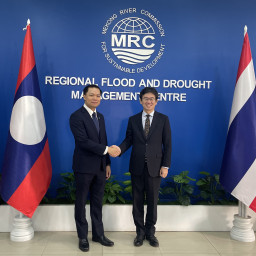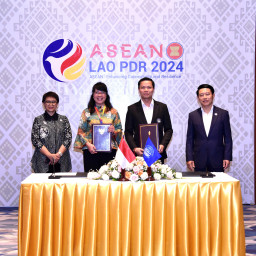200,000 endangered carp bred and released in Mekong
200,000 young fish that can grow to up to 70 kg in weight and over 1.65 metres in length were released into the Mekong today as part of a Lao/Thai breeding programme.
The endangered fish, Jullien's Golden Carp, or Probarbus jullieni, were bred in Thailand. The Lao and Thai governments, supported by the Mekong River Commission (MRC), have been co-operating as part of efforts to protect and preserve giant Mekong species.
The two countries have established "breeding stations" for the fish along the Mekong River in Loei, Nongkhai, Mukdaharn, Nakornphanom and Champassak, where large numbers of young fish (known as fingerlings) have been bred.
"Fish are extremely important in the diets of all those that live along the Mekong, providing more than 50 percent of annual protein," said Jeremy Bird, CEO of the MRC at an event to mark the fish release on the Lao side of the Mekong today. "To encourage conservation of this vital resource, we are stocking the river with fingerlings. Releasing fish into the river system will help conserve vulnerable Mekong species, with a view to maintaining aquatic biodiversity, and guaranteeing the availability of fish today and for future generations."
The initiative for the fish release originated in the Department of Fisheries in Thailand. It has also been promoted by the MRC supported Technical Advisory Body of Fisheries Management. The fisheries agencies of all four riparian countries have been working with the MRC in order to develop propagation techniques for indigenous fish species. Techniques for breeding Jullien's Golden Carp have been developed since 2000 and were tested at several locations in the basin. Fingerlings of the Mekong Giant Catfish, Pangasianodon gigas, or pa beuk have also been grown and released.
Jullien's Golden Carp is one of the largest fresh-water species in Southeast Asia. It migrates great distances up the Mekong to reproduce, with fish swimming from Kompong Cham in Cambodia to Chiang Khong in Thailand, and further up the Nam Ta in Laos to breed.
It is a popular fish for eating, sometimes consumed raw and commands a high market price.
But its popularity has an environmental toll – contributing directly to the low numbers of fish in the wild and prompting regional governments to classify it as an endangered species, with international trade banned.
-ends-
Notes to Editors
Since 2000, the Technical Advisory Body has addressed the sustainable management and conservation of giant Mekong fish species, by studying the status of giant Mekong species, their ecology and management; developing conservation strategies – particularly for the most famous of the giant species, the Mekong Giant Catfish, Pangasianodon gigas, or pa beuk.
Three 'flagship species' have been identified. By giving publicity to these few key species, it is hoped that they can be used to leverage support for sustainable use of entire ecosystems and all species contained therein.
The 'flagship species' are: the Mekong Giant Catfish, the giant barb, and Jullien's Golden Carp, or Probarbus jullieni.
The MRC is the intergovernmental body responsible for cooperation on the sustainable management of the Mekong Basin whose members include Cambodia, Lao PDR, Thailand and Viet Nam. In dealing with these challenges, it looks across all sectors including sustaining fisheries, identifying opportunities for agriculture, maintaining the freedom of navigation, flood management and preserving important ecosystems. Superimposed on these are the future effects of more extreme floods, prolonged drought and sea level rise associated with climate change. In providing its advice, MRC aims to facilitate a broad range of dialogue among governments, the private sector and civil society on these challenges.
Photos available on request
For More Information
Ms Tiffany Hacker, Interim Communication AdvisorTel: +856 56120695 or +856 21 263 263 Ext. 4703
Email: damian@mrcmekong.org
Mr Khy Lim, Communication Officer
Tel: +856 20 5622 8131
Email: khy@mrcmekong.org




